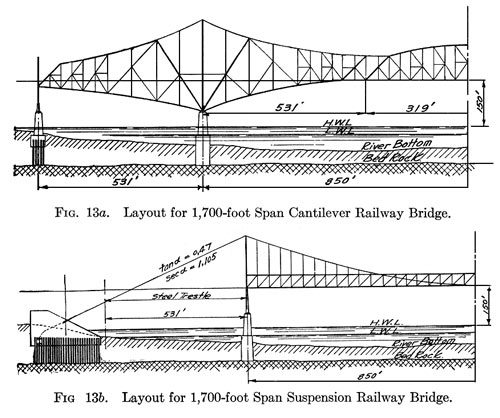| ECONOMICS OF CANTILEVER AND SUSPENSION BRIDGES | 95 |
|
"De Pontibus," viz.: For the suspended span, three-eighths of the main opening; for each cantilever arm, five-sixteenths of the main opening. As before stated, the length of the anchor arm, for the sake of appearance, was made the same as that of the cantilever arm, although some metal would have been saved by assuming it shorter. In the suspension span, also, economic dimensions were used, viz.: one-fortieth of the length for the truss depth, and one-ninth thereof for the deflection of the cables. In order to provide proper splay for the latter (when splay was required), the tower width, as before indicated, was made one-twentieth of the main opening. This militated but slightly against the suspension bridge, because, in the substructure, it generally increased the cost of only the walls between the pedestals of the main piers, the increase being a bagatelle in comparison with the total cost of the said substructure. The first estimates prepared by the author were for double-track-railway bridges; and he assumed, to begin with, an opening of 1,700 feet, which is approximately Dr. Steinman's span-length for equal cost. The profile adopted for this crossing is shown in Fig. 13a and Fig. 13b. It will be seen
that there is a difference of twenty-five feet between high water and low water, that the river bed is some fifty feet below the latter, and that the bed rock is one hundred feet below the same for condition No. 1. In condition No. 2 there is no bed rock, hence the piers and anchorages are supported on piles. As the author had anticipated, the result of the calculations showed a large difference in favor of the cantilever structure, the |
